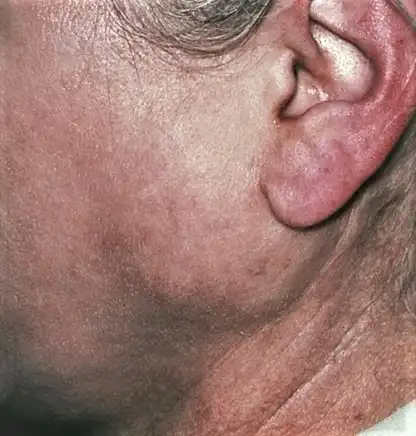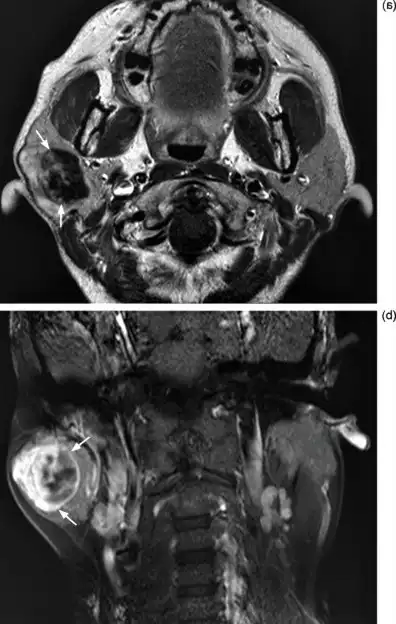سرطان الغدد اللعابية يؤثر على الغدد المسؤولة عن إفراز اللعاب الموجودة في منطقة الفم، ستتعرف على التقنيات الحديثة المتاحة لعلاج سرطان الغدد اللعابية في تركيا.
هناك نوعان من الأورام، الخبيثة (السرطانية) أو الحميدة (غير سرطانية)، كلاها تحدث بأعداد متساوية.
تعتمد فرصة العلاج على مكان وجود السرطان في الغدد اللعابية، وما إذا كان السرطان في المنطقة التي بدأ فيها أو انتشر إلى الأنسجة الأخرى، وكيف تبدو الخلايا السرطانية تحت المجهر، والصحة العامة للمريض.
ما هي الغدد اللعابية؟
هي الغدد المسؤولة عن تصنيع اللعاب وإطلاقه في الفم للحفاظ على رطوبة الفم والحلق كما تساعد في بلع الطعام وهضمه.
تختلف هذه الغدد من ناحية الحجم حيث توجد غدد لعابية كبيرة وصغيرة. هناك ثلاثة أزواج من الغدد اللعابية الرئيسية: الغدة النكفية والغدد تحت الفك السفلي والغدد تحت اللسان.

الغدة النكفية
تقع الغدد النكفية أمام الأذنين وخلف الفك. تفرز اللعاب إلى الفم من خلال أنبوب يسمى القناة النكفية ينفتح هذا الأنبوب من الداخل على الخد بالقرب من منطقة الأضراس العلوية.
يمر عبر الغدة النكفية العصب الذي يتحكم في عضلات الوجه الذي يسمى بالعصب الوجهي، وهو العصب المسؤول عن جعلك تبتسم وتعبس وتغمض عينيك وترفع حاجبيك.
الغدة النكفية هي أكبر غدة لعابية وفيها تحدث معظم سرطانات الغدد اللعابية.
تحتوي الغدد النكفية أيضاً على العقد الليمفاوية وهي عقد تشكل جزءاً من دفاع جهاز المناعة ضد الالتهابات، يمكن أن تنتشر سرطانات الجلد في بعض الأحيان إلى هذه العقد الليمفاوية داخل الغدد النكفية ولكن معظم أورام الغدد النكفية لحسن الحظ ليست سرطانات وتسمى أورام حميدة.
الغدد تحت الفك السفلي وتحت اللسان
تقع الغدد تحت الفك السفلي في منطقة تحت عظم الفك وتوجد واحدة في كل جانب وتطلق هذه الغدد اللعاب في الفم من خلال قناة (أنبوب) تنفتح في أرضية الفم تحت اللسان.
نجد هنالك ثلاثة أعصاب مهمة بجانب هذه الغدد هي العصب تحت اللسان والعصب اللساني والفرع الهامشي من الفكي السفلي للعصب الوجهي، تعطي هذه الأعصاب الحركة والإحساس والذوق للسان وتحرك الشفة السفلية.
يمكن أن تكون أورام الغدة تحت الفك السفلي حميدة (ليست سرطانية) أو خبيثة (سرطانية).
تقع الغدد تحت اللسان كما يوحي اسمها تحت اللسان واحدة على كل جانب. تطلق اللعاب في القناة تحت الفك السفلي، وتقع بالقرب من الأعصاب اللسانية التي تعطي الشعور والذوق في مقدمة اللسان.
الغدد تحت اللسان هي أصغر الغدد اللعابية الرئيسية ونادراً ما تصاب بأورام، ولكن عندما تصاب فإن أورامها تميل إلى أن تكون خبيثة (سرطان) عندما تتطور.
الغدد اللعابية الصغرى
هناك مئات من الغدد اللعابية الصغيرة المنتشرة في الفم والحلق. يمكن العثور عليها داخل الفم أسفل السطح مباشرة بما في ذلك الشفاه والخدين وأعلى الفم (الحنك الرخو). يمكن أن تصاب الغدد اللعابية الصغرى أيضاً بأورام حميدة أو خبيثة.
ما هو سرطان الغدد اللعابية؟
سرطان الغدد اللعابية هو مصطلح يستخدم لوصف الأورام الخبيثة التي تصيب الغدد اللعابية في الفم أو بالقرب منه. قد تكون أورام الغدد اللعابية حميدة (غير سرطانية) أو خبيثة (سرطانية) يحدث كل منها بوتيرة متساوية.
قد يصيب سرطان الغدد اللعابية أي من الغدد اللعابية، يعتمد تشخيصك (توقعاتك) على نوع سرطان الغدد اللعابية الذي تعاني منه ومرحلة المرض (مدى تقدم المرض).
مَنْ المحتمل أن يصاب بسرطان الغدد اللعابية؟
يمكن لأي شخص أن يصاب بسرطان الغدد اللعابية ولكن الرجال يكونون أكثر عرضة للإصابة بأورام الغدد اللعابية.كما يصبح الشخص أكثر عرضة للإصابة بسرطان الغدد اللعابية إذا كان:
- يبلغ من العمر 55 عاماً أو أكثر
- يدخن أو يتعاطى الكحول بشكل متكرر
- يتلقى العلاج الإشعاعي على الرأس أو الرقبة أو يتعرض لمواد مشعة
- يعمل في بعض المهن بما في ذلك السباكة وتصنيع المنتجات المطاطية وتعدين الأسبستوس وصناعات الجلود
أعراض وأسباب أورام الغدد اللعابية
ما الذي يسبب سرطان الغدد اللعابية؟
السبب الدقيق لمعظم سرطانات الغدد اللعابية غير معروف، يمكن أن تحدث أورام الغدد اللعابية في أي غدة لعابية موجودة في الفم أو بالقرب منه. الأكثر شيوعاً منها تحدث في الغدد اللعابية الثلاث الرئيسية التي تتمثل بـ :
- الغدد النكفية (داخل كل خد)
- الغدد تحت الفك السفلي (في قاع الفم)
- الغدد تحت اللسان (تحت اللسان)
يحدث سرطان الغدد اللعابية أيضاً داخل الغدد اللعابية الصغرى المجهرية، تقع هذه الغدد داخل سقف أو أرضية الفم وبطانة اللسان والشفاه وداخل الخدين والجيوب الأنفية والأنف وعلبة الصوت.
قد تكون أورام الغدد اللعابية حميدة أو خبيثة (سرطان)، تنمو الأورام الحميدة بشكل عام ببطء ومن غير المحتمل أن تنتشر إلى أنسجة أخرى،
حوالي 50 بالمائة من أورام الغدد اللعابية غير سرطانية ومع ذلك فإن بعض أورام الغدد اللعابية خبيثة وقد تنتشر إلى مناطق أخرى من الجسم.
ما هي أعراض سرطان الغدد اللعابية؟
عدد قليل من المصابين بسرطان الغدد اللعابية ليس لديهم أعراض، في معظم الحالات يتسبب سرطان الغدد اللعابية في ظهور كتلة غير مؤلمة في الغدد اللعابية.

إذا كان ورم الغدد اللعابية خبيثاً فمن المرجح أن تعاني من أعراض أخرى بما في ذلك:
- ضعف أو تنميل في الوجه أو الرقبة أو الفك أو الفم.
- ألم مستمر في الوجه أو الرقبة أو الفك أو الفم.
- صعوبة فتح فمك بالكامل أو تحريك عضلات وجهك.
- صعوبة البلع.
- نزيف من الفم.
التشخيص والاختبارات
كيف يتم تشخيص سرطان الغدد اللعابية؟
يقوم طبيبك بتشخيص سرطان الغدد اللعابية من خلال الفحص البدني ومراجعة تاريخك الطبي والشخصي.
في بعض الحالات يطلب الأطباء إجراء اختبارات تشخيصية إضافية للتأكد من وجود ورم، تشمل هذه الاختبارات:
- التصوير المقطعي المحوسب باستخدام الأشعة السينية لتوفير صور للكتل داخل الغدد اللعابية
- التصوير بالرنين المغناطيسي MRI والذي يستخدم المغناطيس وموجات الراديو لإنشاء صور لهياكل الجسم الداخلية
- التصوير المقطعي بالإصدار البوزيتروني PET باستخدام كميات صغيرة من المواد المشعة لتحديد الكتل السرطانية
- خزعة بإبرة دقيقة لجمع عينة صغيرة من الأنسجة والسوائل من ورم الغدة اللعابية لمزيد من الفحص في المختبر

تشخيص سرطان الغدد اللعابية بواسطة الرنين المغناطيسي
متى يجب عليّ الاتصال بطبيبي؟
إذا كان لديك أي من أعراض ورم الغدد اللعابية المذكورة أعلاه خاصة إذا استمرت الأعراض لأكثر من أسبوعين فاتصل بطبيبك لإجراء تقييم تشخيصي.
ما هي مراحل سرطان الغدد اللعابية؟
بمجرد اكتشاف سرطان الغدد اللعابية سيتم إجراء مزيد من الاختبارات لمعرفة ما إذا كانت الخلايا السرطانية قد انتشرت إلى أجزاء أخرى من الجسم. هذا يسمى التدريج، يحتاج الطبيب إلى معرفة مرحلة المرض للتخطيط للعلاج.
تصنف سرطانات الغدد اللعابية حسب “الدرجة” والتي تخبرنا بمدى سرعة نمو وانتشار الخلايا السرطانية بناءً على شكل الخلايا تحت المجهر. تنمو السرطانات منخفضة الدرجة بشكل أبطأ من السرطانات عالية الدرجة.
تستخدم المراحل التالية لعلاج سرطان الغدد اللعابية:
المرحلة الأولى من سرطان الغدد اللعابية
يبلغ قطر السرطان 2 سم أو أقل ولم ينتشر خارج الغدد اللعابية.
المرحلة الثانية من سرطان الغدد اللعابية
السرطان أكبر من 2 سم ولكن قطره لا يزيد عن 4 سم ولم ينتشر خارج الغدد اللعابية.
المرحلة الثالثة من سرطان الغدد اللعابية
- قد يكون أي مما يلي صحيحاً: يبلغ قطر السرطان أكثر من 4 سم وانتشر في الجلد أو الأنسجة الرخوة أو العظام أو الأعصاب حول الغدة، قد يكون السرطان قد انتشر إلى عقدة ليمفاوية واحدة أو لم ينتشر.
- حجم السرطان أقل من 4 سم وانتشر إلى عقدة ليمفاوية واحدة.
المرحلة الرابعة من سرطان الغدد اللعابية
المرحلة الرابعة الأولى
قد يكون أي مما يلي صحيحاً:
- انتشار السرطان في الجلد أو الأنسجة الرخوة أو العظام أو الأعصاب حول الغدة اللعابية وقد يصل حجمه إلى 6 سنتيمترات، وربما انتشر إلى عقد ليمفاوية واحدة أو أكثر ولكنه لم ينتشر إلى أجزاء أخرى من الجسم.
- السرطان بأي حجم وانتشر إلى الأنسجة القريبة وانتشر إلى عقدة ليمفاوية واحدة على نفس الجانب من الرقبة حيث السرطان وإلى العقد الليمفاوية على جانبي العنق أو إلى أي عقدة ليمفاوية.
المرحلة الرابعة الثانية
قد يكون أي مما يلي صحيحًا:
- انتشر السرطان إلى عظام الجمجمة و / أو الشريان السباتي المحيط بها، وهو الشريان الرئيسي (الأيمن والأيسر) للرقبة الذي ينقل الدم إلى الرأس والدماغ، وربما انتشر إلى عقد لمفاوية واحدة أو أكثر.
- السرطان أكبر من 6 سم وقد ينتشر إلى الأنسجة المجاورة، وانتشر إلى عقدة ليمفاوية واحدة على الأقل.
المرحلة الرابعة الثالثة
قد يكون السرطان بأي حجم وقد يكون قد انتشر إلى الأنسجة القريبة والعقد الليمفاوية وانتشر إلى أجزاء أخرى من الجسم.
تكرار ونكوس سرطان الغدد اللعابية
يعني تكرر عودة السرطان بعد علاجه، قد يعود في الغدد اللعابية أو في جزء آخر من الجسم.
علاج سرطان الغدد اللعابية
عادةً ما تكون الجراحة هي أفضل خيار علاجي للأورام الحميدة التي يمكن إزالتها بأمان، بعد الجراحة يركز تعافيك على منع العدوى وإدارة الألم، قد يصف لك طبيبك أدوية مثل المضادات الحيوية ومسكنات الألم لتحقيق هذه الأهداف.
أما في حال كان الورم ينمو بسرعة أو إذا انتشر إلى أجزاء أخرى من الجسم فقد يوصي الطبيب الخاص بك بعلاجات إضافية، تشمل هذه العلاجات:
الجراحة
الجراحة هي العلاج الأساسي لأورام الغدد اللعابية الخبيثة، قد يقوم الجراح بإزالة العقد الليمفاوية (استئصال العقد اللمفية) بالإضافة إلى إزالة الورم في حال اشتبه بانتشار السرطان هناك. بعد الجراحة من المحتمل أن تتلقى العلاج الإشعاعي لقتل أي خلايا سرطانية متبقية حتى لا يعود السرطان.
العلاج الإشعاعي
يتم في العلاج الإشعاعي استخدام جهاز يوجه الإشعاع نحو جزء من الجسم به خلايا سرطانية ليدمرها، هناك نوعان من العلاج الإشعاعي المستخدم لعلاج سرطان الغدد اللعابية هما حزمة الفوتون والنيوترون.
قد تتلقى أيضاً إشعاعاً كجزء من الرعاية التلطيفية، توفر الرعاية التلطيفية تخفيف الأعراض وتحسين تجربة العلاج والحياة العامة.
العلاج الكيميائي
يستخدم العلاج الكيميائي الأدوية لتدمير الخلايا السرطانية، قد تتلقى العلاج الكيميائي إذا انتشر السرطان من الغدد اللعابية إلى الأنسجة الأخرى خارج الرأس والرقبة.
المتابعة بعد العلاج
قد يتم تكرار بعض الاختبارات التي تم إجراؤها لتشخيص السرطان فيما بعد لمعرفة مدى نجاح العلاج، تبنى القرارات المتعلقة بمواصلة العلاج أو تغييره أو إيقافه بالإعتماد على نتائج هذه الاختبارات.
سيستمر إجراء بعض الاختبارات من وقت لآخر بعد انتهاء العلاج، تظهر نتائج هذه الاختبارات ما إذا كانت حالتك قد تغيرت أو إذا تكرر السرطان (عاد)، تسمى هذه الاختبارات باختبارات المتابعة أو الفحوصات.
المصادر
